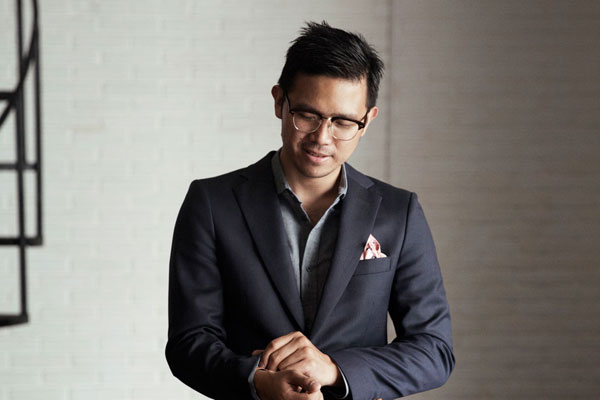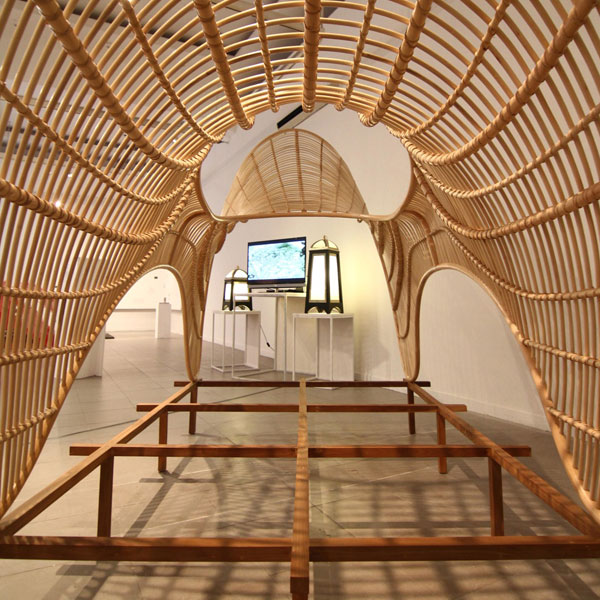Alvin Tjitrowirjo digs deep into his roots in search of inspiration to create a design language that defines his eponymous furniture label and interior practice, and in the process sheds new light on contemporary Indonesian culture, writes Stephanie Peh.

January 19th, 2015
At the beginning of his career, Indonesian product designer Alvin Tjitrowirjo worked with local manufacturers who were keen to create their own furniture. However, his forms were deemed too modern for consumers. Instead of moulding his artistic sense to satisfy market demands, Tjitrowirjo started his own furniture label, Alvin-T.
Having spent some time in Europe, he understood the infrastructure required for a successful brand, but that knowledge alone was missing a vital ingredient – a design identity that resonated with his heritage. He roamed his home country in search of inspiration, observing Indonesian craftsmen at work, and studying the characteristics of homegrown materials. “At that point, no one in the industry was doing anything to promote our cultural wealth through design. That became my drive to make a change,” says Tjitrowirjo. His respect for traditional Indonesian art and history soon became the soul behind his work. For Tjitrowirjo, Alvin-T goes beyond beautiful household statements. The brand was meant to symbolise a new era in modern Asian design, coupled with a bold display of homegrown capabilities.
Tjitrowirjo’s design sensibilities date back to grade school, when he first became fascinated with automotive design. He spent time observing vehicle parts, which led him to pursue industrial design at the Royal Melbourne Institute of Technology (RMIT), where he learnt about the function of design and its impact on human behavior. Furniture design became a creative medium for him to create meaningful interactions. After multiple successful collaborations with various brands, and esteemed design figures back home, the young designer left for Europe, completing a master’s degree in product design at the IED Instituto Europeo di Design in Madrid, as well as a stint with esteemed Dutch designer, Marcel Wanders.
The Alvin-T team abides by a stringent and balanced creative process that begins from careful market research, leading to the inception of original ideas. “We always start with a specific story or campaign, something that we believe in and want to share,” he explains. After the initial idea, stages of prototyping, trial-and-error and quality checks are performed. The team works closely with local artisans to arrive at a level of refined simplicity. The elaborate process is key to Alvin-T’s consistent push towards innovation. For example, the workmanship of bent natural rattan is a recurring feature across Tjitrowirjo’s pieces. Despite the flexible material being often associated with outdoor or cheap and dated Asian furniture, Tjitrowirjo wanted to show that it could be viewed from a contemporary standpoint.
Organic lines and neutral colours inspired by the abundance of nature present in Indonesia are also common characteristics found in his collections. Tjitrowirjo deliberately leaves his chosen materials in naked glory. This is a bold step away from the market’s tendency towards ostentatious bling, where even a simple material such as plywood is often asked to be masked. “I want to bring out the best in each material, so that our products look good by being themselves, and not something they are not,” he explains.

Chrysalis installation in rattan
Aside from rattan, he experiments with bamboo, marble, stone and teak (reclaimed from old houses), worked on by the hands of Indonesia’s finest. His playful take on curating materials is perhaps more evident in the spatial experiences that he has created for cafés and restaurants in Jakarta and Bali. A case in point would be the Porterhouse Restaurant, where upcycled materials such as wood, metal and cement tiles found in Central Java were reclaimed. As he does with furniture, Tjitrowirjo exercises a similar heritage mindfulness in his interior projects. The combination of batik patterns and colours present in Dapour 100 Eatery & Bar is more than a mere reinterpretation of old production methods, but a reflection of the diversity in Indonesia food culture. In this lifestyle space, Tjitrowirjo creates overlapping intricate details that denote an evolution in design history.
“I use a lot of my gut feeling and emotions whenever I design something. It is a long process of fine-tuning to meet the quality standard,” he reveals. Despite the marriage of modern aesthetics and traditional craftsmanship being a consistent outline in his work, Tjitrowirjo has carved out a new identity for contemporary Indonesian design by listening to his inner voice.
Alvin-T
alvin-t.com
A searchable and comprehensive guide for specifying leading products and their suppliers
Keep up to date with the latest and greatest from our industry BFF's!

Sub-Zero and Wolf’s prestigious Kitchen Design Contest (KDC) has celebrated the very best in kitchen innovation and aesthetics for three decades now. Recognising premier kitchen design professionals from around the globe, the KDC facilitates innovation, style and functionality that pushes boundaries.

In the pursuit of an uplifting synergy between the inner world and the surrounding environment, internationally acclaimed Interior Architect and Designer Lorena Gaxiola transform the vibration of the auspicious number ‘8’ into mesmerising artistry alongside the Feltex design team, brought to you by GH Commercial.

Savage Design’s approach to understanding the relationship between design concepts and user experience, particularly with metalwork, transcends traditional boundaries, blending timeless craftsmanship with digital innovation to create enduring elegance in objects, furnishings, and door furniture.
The internet never sleeps! Here's the stuff you might have missed

The AIA Alta Wellness Haven offers the complete package for health and wellbeing away from the busy city life in Hong Kong and does it through a stellar interior design.

Salone del Mobile 2024 is only a few weeks away, so we’re highlighting here seven special events, spaces and installations that we’re certainly planning to check out.